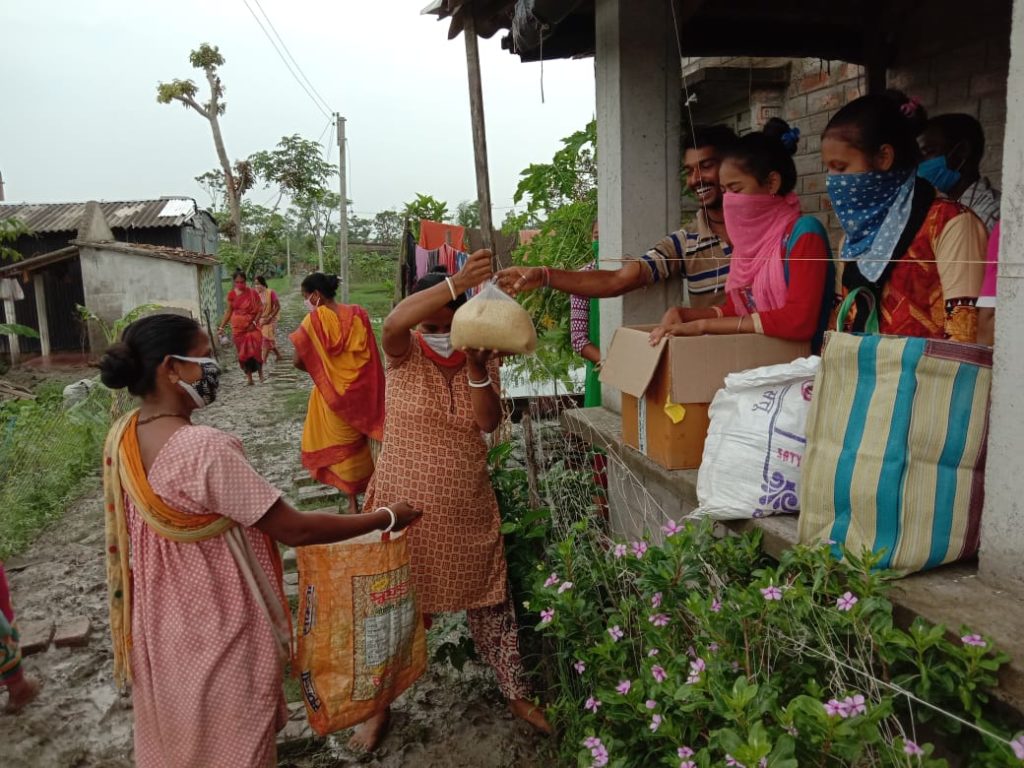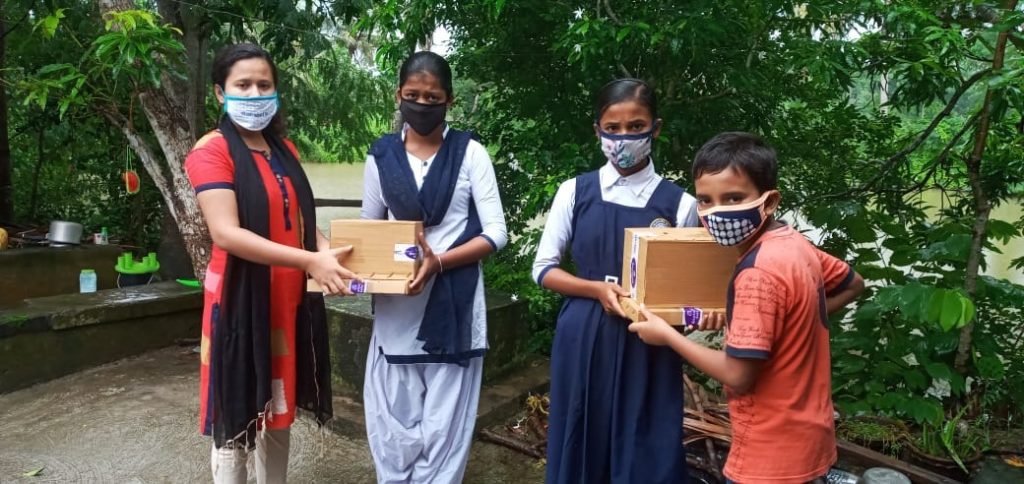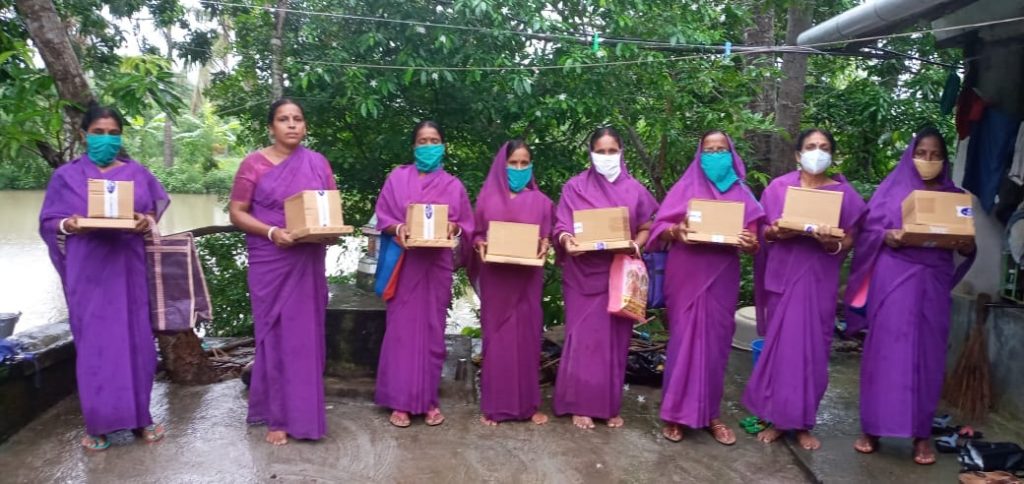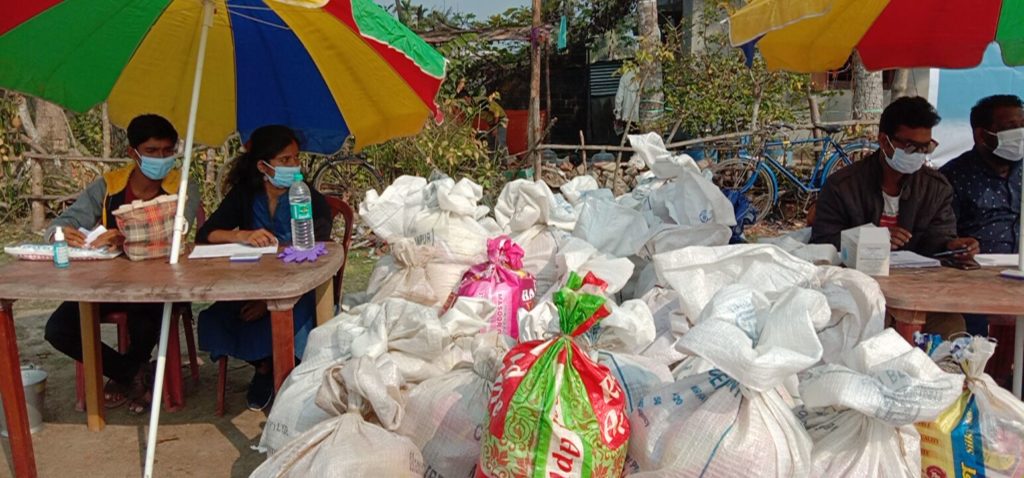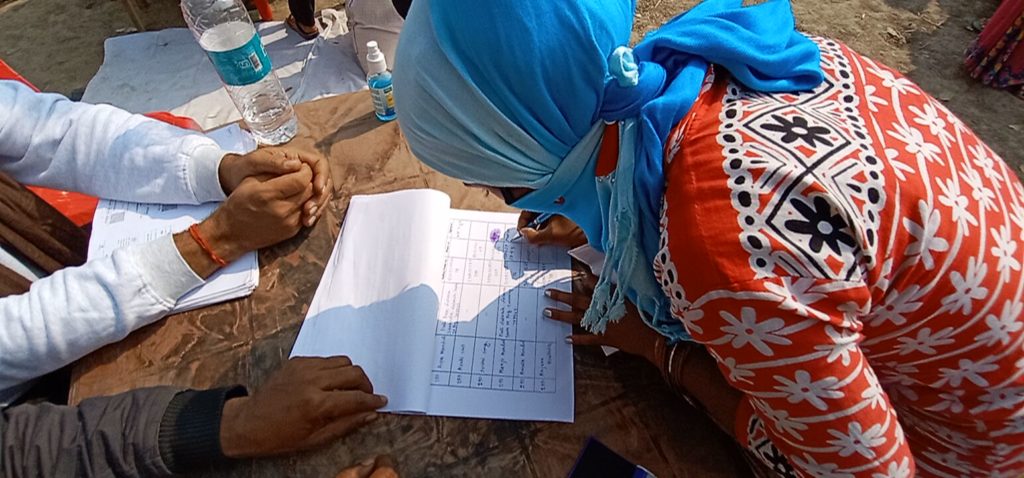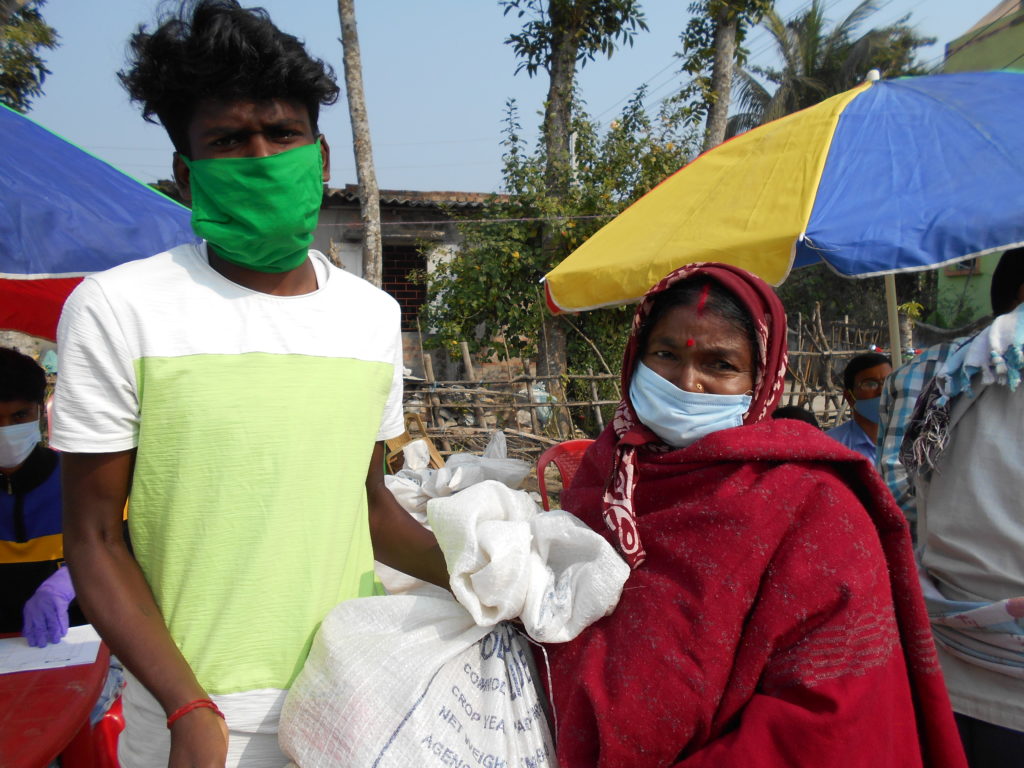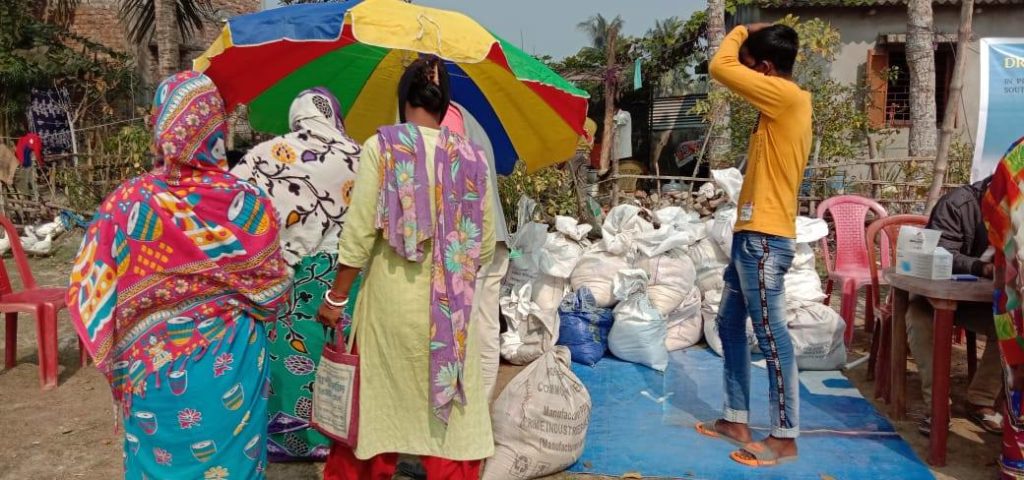Other Activities | অন্যান্য কাজ
Launch of the first Bangla digital archive on gender resources called ‘Alape Gender' (Talks Around Gender)/ বাংলায় প্রথম জেন্ডার আর্কাইভ 'আলাপে জেন্ডার'-এর উদ্বোধন
On 6th March 2021, we launched the first Bangla digital archive on gender resources called ‘Alape Gender' (Talks Around Gender). Please visit the archive at https://ebongalapgenderarchive.com/
We flagged off our new endeavour with four sections while we expect to add more as we continue our journey.
The four sections are:
‘Lockdown o Amader Jiban’ (Lockdown and Our Lives) ‘Math Kamre Bnacha’ Lifestories of (Women in Sport)
‘Bera Bhangar Galpo’(Bodies and Barriers centred around gender and sport)
'Amar Dekha 8ই March' ( The observation of 8th March in West Bengal)
There were an array of online events to mark the launch of the digital archive between 6th and 9th March, 2021, coinciding with the commemoration of International Working Women’s Day. All online events held on the occasion can be viewed here: https://ebongalapgenderarchive.com/%e0%a6%86%e0%a6%b2%e0%a6%be%e0%a6%aa%e0%a7%87-%e0%a6%9c%e0%a7%87%e0%a6%a8%e0%a7%8d%e0%a6%a1%e0%a6%be%e0%a6%b0-alape-gender-home/events/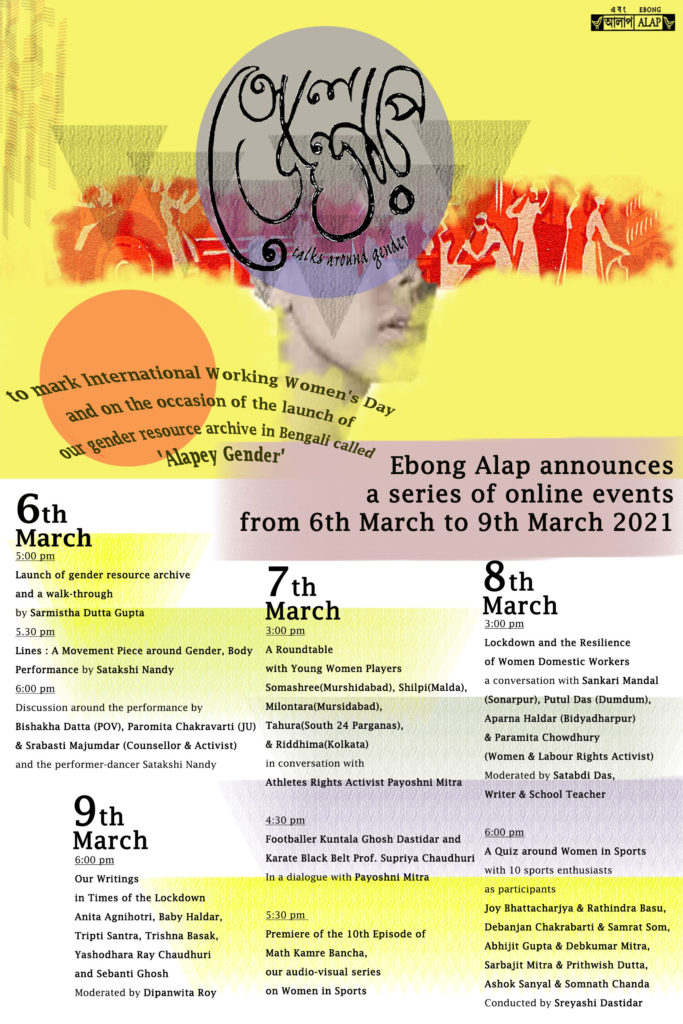
Covid & Cyclone Amphan Relief Work । কোভিড এবং সাইক্লোন আমফান ত্রাণ উদ্যোগ
-
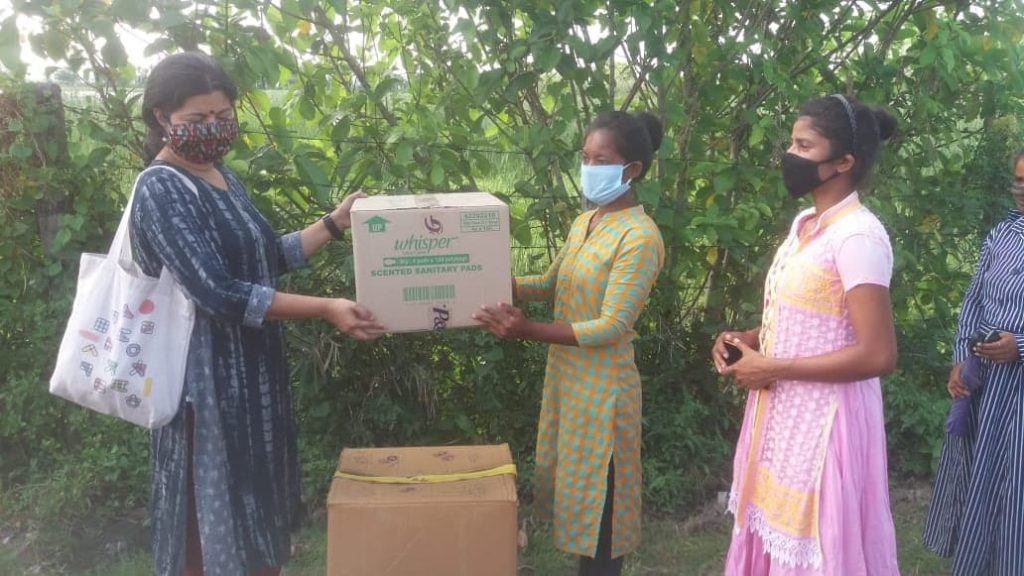
Relief work in East Kolkata Wetlands
After the devastation caused by cyclone Amphan in south Bengal in May 2020, Ebong Alap has been organising relief primarily for female-headed households and to elderly or single women living alone in some of the worst affected areas. In the first phase our team visited Gosaba and Canning blocks of South 24 Parganas to provide immediate relief to about 200 families in the form of clothing, dry ration, medicines, sanitary napkins, nutrition supplements etc. Educational support to adolescent students were provided to Piyali area under Canning block in June 2020. In the second phase we provided monetary help through bank transfers to people who have lost their homes in Amphan in the east Kolkata wetlands, in Hingalganj and Joynagar blocks of North and South 24 Parganas respectively. In the third phase in July, Ebong Alap reached Satjelia of Sunderbn to provide some relief to local elderly people and ASHA workers with solar lanterns with mobile charging sockets. In August, we distributed solar lanterns cum mobile chargers to high school students and ASHA workers of Mousuni island of Sunderban. This was done in collaboration with the group Shudhu Sunderban Charcha. We reached ASHA workers of 7 Gram Panchayats of Habra1 block in North 24 Parganas with solar lanterns cum mobile chargers in September 2020.
Another relief work of the very difficult year of the pandemic was undertaken on 30th December 2020 by Ebong Alap with distribution of dry ration to 400 families in Canning, South 24 Parganas. This was supported by Tech Mahindra Foundation.
For more images of our relief work, please visit gallery.
Policy Interventions | নীতি নির্ধারণ
Ebong Alap organized in May 2013 a colloquium on safety and well-being of women and girls on campuses of West Bengal. College teachers and directors of Women’s Studies centres from across the state participated. This was done in collaboration with UGC’s Eastern Regional Office and Calcutta University Women’s Studies Research Centre. The recommendations of this consultation have been later included in the UGC report ‘SAKSHAM: Measures for ensuring Safety of Women and Programmes for Gender Sensitisation on Campuses’ published in December 2013. For our recommendations emerging out of the colloquium please see the SAKSHAM report.
view full report media report on the colloquium
Pedagogy and Performance | পারফরমেন্স ও শিক্ষণ
Rabindranath's Muktadhara in Sunderban
On 23 April 2012 a site-specific performance based on Rabindranath Tagore’s Muktadhara was staged at Bijoynagar Adarsha Vidyamandir in the Bali island of the Sundarbans. This production was produced by Ebong Alap with Ranan and Bijoynagar Adarsha Vidyamandir. A grant from the Tagore Commemoration Grant Scheme of the ministry of culture made this possible.
In the pre-production meetings between Ebong Alap and Ranan it was decided a script would be written that would take off from Rabindranath Tagore’s Muktadhara rather than performing Muktadhara itself. The members of Ranan would visit the school and organise pre-production workshops with a selection of interested students, and the final production script would emerge from the workshop interactions. The workshop would throw at the students some of the primary concepts arising in the play script and document their immediate responses to these issues. These responses would then be incorporated into the eventual production script. The aim of the entire exercise was to create a dialogue between the actors, audience and the original and the subsequent play text that would perhaps lead to a critical engagement with the issues that Tagore’s text proposes.
The school is located in the Bali island of the Sundarbans. The school itself is located a few hundred yards away from the jetty and was badly affected during the cyclonic storm (Aila) of 2009. The students of the school are from the island itself or from other islands in the Sundarban area and their lives are largely structured by the benevolence and malignance of natural forces. Hence when conceptualising the staging of a play based on Muktadhara it was felt that this play would set off strong resonances among the participants and the local audience, as Muktadhara explores the issue of life sustaining natural resources and its use and abuse. Members of Ranan who were working with the school children and preparing the script decided to break out of the limitations of the proscenium and use the entire central yard of the school as the performance area, in the process incorporating certain features of that space into the script. These features included a large tree in the yard and a mobile phone tower that looms over the school. The yard also had a stage which was also used during the production as a closed indoor space for interactions between the characters.
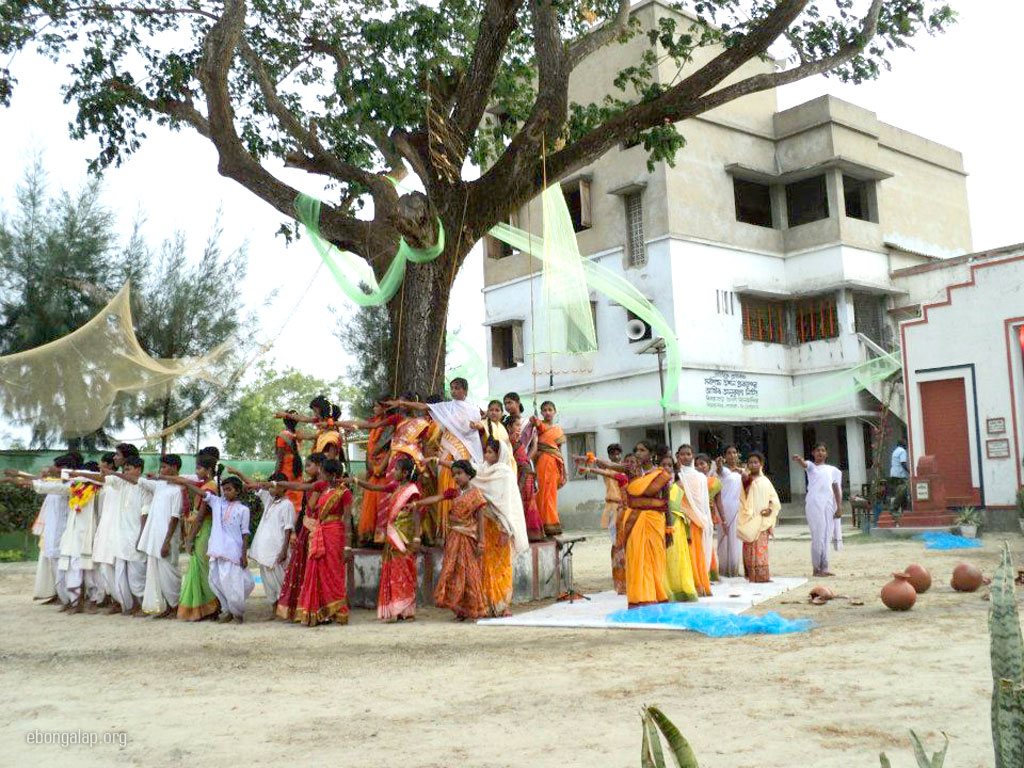
Rabindranath's Muktadhara in Sunderban The beginning of the play saw the large cast of about fifty schoolchildren entering the performance arena through the school gate singing a song. This song and all the other songs sung by the schoolchildren in the play had been pre-recorded some days prior to the performance in a Kolkata studio by Ranan. The tree in the yard acted as a pivot and most of the action revolved around the tree which was beautifully done with gossamer like green and brown fabrics that stretched from the trunk to the branches to other trees and lamp-posts. Underneath the tree, on a platform built around the circumference of the tree, there was a stool placed for the actor who would be playing a teacher in an open air classroom, with mats laid out on the earth below to seat the students. A hammer and gong was slung from one of the branches of the tree, as was also a drum. There was also some sound equipment which was camouflaged with green fabric and some creepers. Microphones were spread out all over the performance area neatly camouflaged with broken branches and leaves so that different areas of the space could be used, signifying the different locales in the play script. The actual school stage was bare of props except billowing sheets red and blue fabrics that created a brilliant space without making it a specific locale. The play itself followed a structure where a classroom interaction and storytelling is interspersed with the playing out of sections of Muktadhara. It is these classroom scenes of the play that bring forth the reactions of the local community to the issues that the play highlights, that Ranan members had gleaned from the pre-production workshops.
The mobile phone tower worked very well to represent the intrusion of technology or yantra into the lives of the people. Towards the end of the play, in an act of rebellion against the mechanical damming of water which caused immense hardship to the people, the roof top of one side of the school and the sloping roof of the stage adjacent to that side of the building were used to pour down numerous pots of water signifying the breaking of the dam. This particular scene had been brilliantly conceptualised, capturing the drama of the moment of rebellion. Eventually everyone had a share of nature’s bountiful gifts. At the end all the actors came together under the shade of the tree to sing the final song of the play to loud applause from the audience that consisted of their school mates, who watched the play from the corridors of the two floors of the school building that ran alongside the performance area, the parents and other members of the local community, who were sat on benches on one side of the performance area, and several guests who were sat on another side. The day’s programme ended with the felicitation of the Headmaster of Bijoynagar Adarsha Vidyamandir for his encouragement and enthusiastic engagement with this long process of script writing and staging the performance. The students who participated in the production were all given copies of Chhelebelae Rabindranath. The school on its part had a memento for all the members of Ranan and Ebong Alap, a copy of some quotes from Rabindranath Tagore.
Dasher Alap | দশের আলাপ
Ebong Alap celebrated 10 years of its work in February 2014 with a programme called Dasher Alap. Everyone who had been part of Ebong Alap’s many and varied activities over the last 10 years were invited to participate. For example, artists and art students from Shantiniketan who put up installations on the occasion, college students from Bardhaman, writers of the Alap Series of books, members of Disha in Sundarbans. All contributed richly to this celebration. Here is an account by Kala Bhavan research scholar Bhaskar Hazarika about the installation and performance art they put up on the occasion. Bhaskar writes:
Basically the installation was an assemblage of various quotations, slogans, rhetoric and images published in the media on forms of protest, censorship, freedom of expression, social and domestic violence, hegemony of the state, exploitation, human rights and related issues in present-day India. Often the images and texts were brought from our own memory and experiences and some of the images used were from Ebong Alap publications. Being a student of fine art, our basic focus was to translate these issues into visual images. Visual translation or re-interpretation of all the socio-political issues, which were already published textually, was quite difficult for us as the basic idea was not to illustrate what is given already but to create the possibility for a discourse through visual representation.
We used popular styles of image representation, such as freehand writing and drawing, which are very commonly found in wall writings and handwritten posters. Then we arranged a range of material for the installation. After the installation, we did a performance which activated the theatricality of the space. The performance was a vocal sound-making exercise introduced to us by Prof. Sanchayan Ghosh of Kala Bhavan. The performance was about a word to word journey phonetically, which was synchronized with our own breathing rhythm. By repetitively uttering a particular word of one dialect, in varying volume, scales and ranges, we started distorting the word gradually and then again we tried to reconstitute the distorted sounds to a different word of a different dialect (synonymous words, for example, water to pani). So the performance was largely about a transitional duration where there is no fixed meaning of a word which can be constituted or found except pure sound.
Other Innovative Initiatives
Ebong Alap jointly with Association Snap, organized a guided walk for a group of Calcuttans around parts of the city which are usually excluded from heritage walks for its links with minority communities. The participants met for an inter-community dialogue after the walk in a local school and had a meal together a couple of days before Eid in July 2016. For media reports of the walk, see the links below:
-

